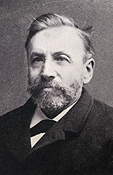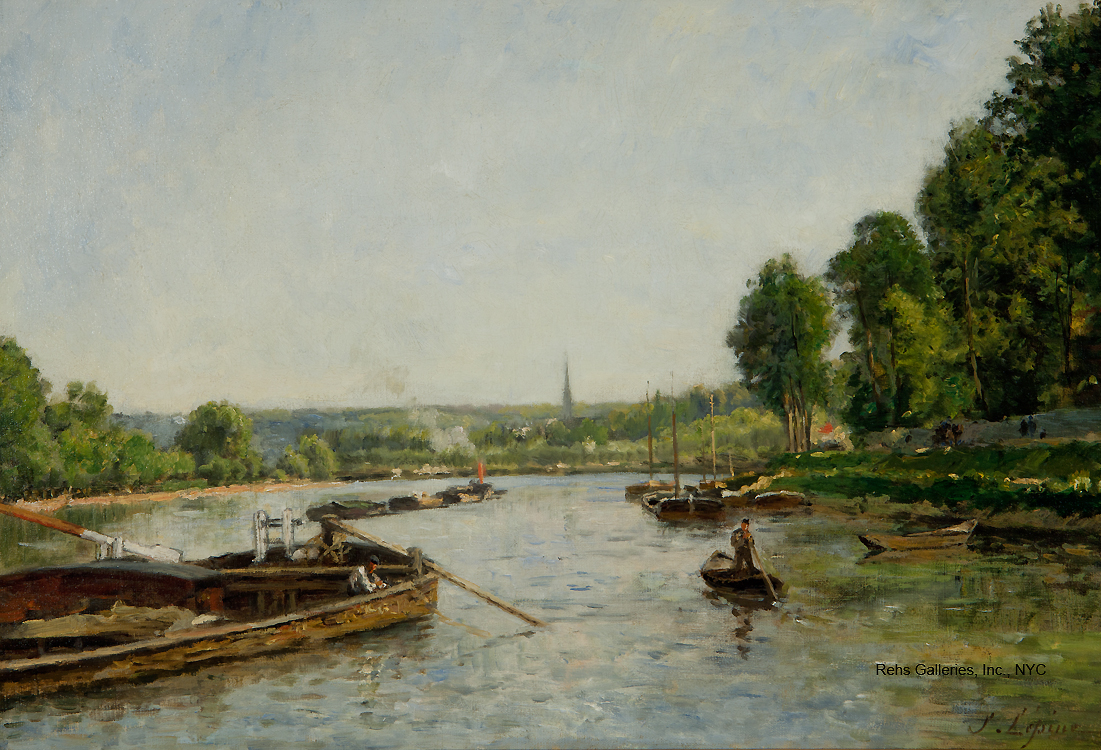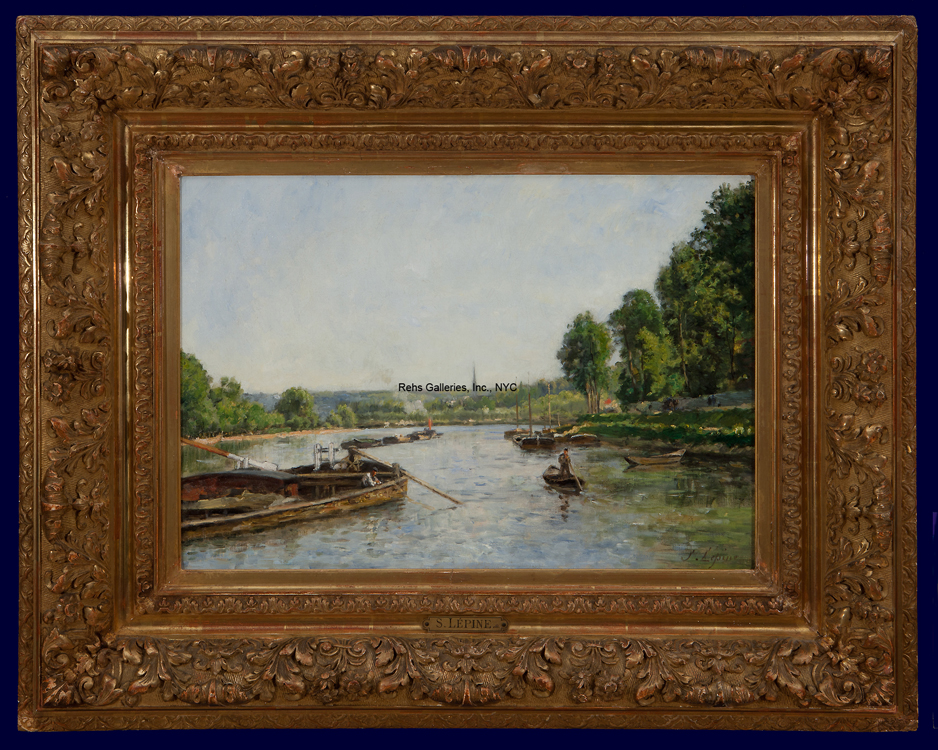Stanislas Lépine
(1835 - 1892)
La Seine a Ivry
Oil on canvas
15 x 22 inches
Framed dimensions:
26 x 33 inches
Signed
BIOGRAPHY - Stanislas Lépine (1835 - 1892)

Lépine lived in isolation outside the artistic circles, devoted only to his work, and he essentially did not belong to his time, as he was one of the first to contribute, as appropriately stated, by M. George Lecomte ‹‹to ruin the academic landscape by learning how to render the effects of light and atmosphere››; therefore there is good reason to reclaim his rightful position to be among the promoters of the movement that influenced the modern School towards using bright colors; indeed from the beginning his works displayed a tendency to experiment with intense and bright colors, and with the remarkable effects of light.
Emile Cardon, extract from the preface of the 1892 Lépine exhibition catalog, quoted in John Couper’s Stanislas Lépine, 1835-1892: Sa Vie, son oeuvre (Paris, 1969, pg. 77)
Considered as one of the forerunners of Impressionism, Stanislas Lépine made his reputation painting Parisian landscapes, particularly the River Seine with its steep banks, bridges and barges, and the old streets of Montmartre. Influenced by his childhood along the coast of Normandy, Lépine also produced numerous marine paintings mostly of port views in Caen and Rouen; and he became specialized in depicting moonlight views mostly in his imagery of ports and the canals of Paris.
While he achieved modest success during his lifetime, Lépine began to gain some critical acclaim after his death. In a review of one of the retrospective exhibitions for Lépine, the art critic Paul Jamot wrote in the Revue de l’Art et de la Curiosité, 1906, “he is the charming, subtle and discreet painter of the Parisian landscapes” and “no other artist has better evoked the atmosphere and light of our city… the modest and sincere Lépine should occupy a privileged position in between Corot and Jongkind.” (Quoted in Couper, pg 79)
Stanislas-Victor-Edmond Lépine was born on October 3, 1835 in Caen, in the Normandy region of France. There is little information about his childhood and artistic formation. However, the writings available on Lépine, note that he probably came from humble origins, and that his father was a cabinet maker. During his childhood, he had a constant companion, Marie-Odile-Emilie Dodin, whom he would later marry, and have three children. At some point, Lépine pursued his studies at the Lycée Chaptal in Paris, although it is not known whether he had obtained a scholarship or not. (Robert Schmit, Stanislas Lépine, 1835-1892: Catalogue Raisonné de L'œuvre Peint, Paris: Editions Galerie Schmit, 1993, pg. xv).
At age 18, Lépine decided to dedicate himself to painting, and saved enough money to buy colors and brushes. He trained himself to become a painter and made copies from the Louvre Museum in Paris, one of which his mother showed to an art teacher, who recognized his talent and said that he would have a future as an artist. Between 1854 and 1856 Lépine visited a number of artists’ studios, where he probably met some of his contemporaries, including Adolphe-Félix Cals (1810-1880), and Théodule Ribot (1823-1891), with whom he formed friendships. His works during that period included views of ports, estuary scenes and beaches, which as Couper stated displayed a lack of maturity in composition, and were dominated by somber colors of dull greens with a variation of browns. (pg. 89)
Being from Normandy, water would always play a pivotal role in Lépine’s artwork. In addition, he admired the Dutch painter Johan Barthold Jongkind (1819-1891), and was especially influenced by his marine pictures, which brilliantly captured the effects of air and atmosphere, as well as by his moonlight views. As noted by Athena S. E. Leoussi, Lépine “learnt from Jongkind not only how to paint ships accurately but also how to render the depth of the sky and the clarity of waves.” (Lépine, Stanislas,” Grove Art Online Dictionary) In 1859, Lépine made his debut at the Paris Salon with one of a number of nocturnes of the port of Caen that he produced at the time, entitled Port de Caen, Effet de Lune (Port of Caen, Moonlight Effect).
That same year, Lépine took up residence in Montmartre, in the north of Paris, and while he moved a number of times, he always remained within the same quarter for the rest of his life. Around that time, Lépine became interested in landscape painting, and was inspired mostly by the River Seine, its banks, bridges and barges, as well as with the old streets of Paris and Montmartre. In the 1860s, Lépine was apprenticed to Jean-Baptise Camille Corot (1796-1875), one of the most celebrated landscape artists, however, the exact dates are not known, as he only began to identify himself as a “student of Corot” in the 1866 Salon catalog. Lépine had a great admiration for his master, and as noted by Cardon “from him, he acquired a love of nature, and like him, was a poet interpreting beauty.” (Couper, pg. 76) Corot’s influence was apparent in many of his works, even before he began to study with him, a matter that did not escape the art critics throughout his career. Alfred Darcel was one of the art critics who made references to this influence as early as 1863, when he wrote that Lépine’s Le Pont des Invalides (The Bridge of the Invalids) exhibited at the 1863 Salon “strongly recalls some scenes of Corot.” (Couper, pg. 61)
Lépine was a quiet and modest man, who was isolated from the artistic circles. He devoted his time to art, and did not frequent the cafés in Paris such as La Nouvelles Athènes, la Brasserie des Martyrs, and café Guerbois and café Riche where other artists usually gathered. However, he occasionally went to the Bon Bock, a meeting spot for artists, poets, musicians, amateurs and art collectors, and where the artists Alfred Sisley (1839-1899) and Eugène Boudin (1824-1898) often visited. On the other hand, Lépine enjoyed a number of friendships with some artists like Cals, Ribot, and Henri-Fantin Latour (1836-1904), and with the art amateur Charles Ricada, with whom he corresponded from 1885 until 1891. He also came into contact with the modernist painter Édouard Manet (1832-1883) who painted a portrait of Lépine’s wife in 1878. (Sophie Monneret, Impressionisme et son époque: Dictionnaire International, Noms propres A à T, Paris, 1978-81, pg. 443)
Even though Lépine regularly exhibited at the Paris Salons since his debut in 1859, he faced financial hardship throughout his artistic career. In 1864, he began to collaborate with the art dealer Pierre-Firmin Martin known as Pére Martin, who sold the works of many artists including Jean-François Millet (1814-1875), Corot, and Cals in his shop in the Rue Mogador. At that time, Pére Martin introduced Lépine to Count Armand Doria, who became his most important patron. However, he continued to find it difficult to sell his works, and his only consolation was that they were appreciated by connoisseurs. As noted by Couper, the 1870 sale catalogs showed that one or two of Lépine’s works were found among many distinguished collections, namely those belonging to Doria, Tavernier, Ricada, Félix Gérard, Henri Rouart and Hazar. (pg. 22)
Beside Pére Martin, Lépine collaborated also with the art dealer Paul Durand-Ruel. However, both their purchases did not provide him with sufficient funds to survive, and Lépine had to find other avenues of support, such as organizing his own auctions. Between the years 1872 to 1886, he organized six public art auctions at the Hotel Drouot. The first was on February 11, 1874, where he submitted 32 works, four represented views of Caen, five of Montmartre, nine of Paris mostly showing the River Seine at Bercy and Ivry, one marine, and the others depicting the outskirts of Paris. The following year on March 17, Lépine submitted 23 works, and they fetched a total of 7,180 francs, averaging 312 francs per picture. Couper points out that while these prices do not seem high, interestingly, one week later, other artists including Claude Monet (1840-1926), Pierre-Auguste Renoir (1841-1919), Sisley and Berthe Morisot (1841-1895) participated in an art auction and their works fetched less than Lépine’s. Morisot’s works averaged the highest with 250 francs per picture, followed by Monet with 165 to 325 francs, and Sisley between 50 and 300 francs. (Couper, pg. 23)
Lépine always painted within a geographical area limited to Paris, its surroundings, as well as Caen, Rouen and other villages in Normandy. As a result, his subject matter did not greatly vary throughout his artistic career. Beside a number of portraits, mostly of his family, and some still-lifes, the subjects of his paintings could be divided into three categories: “first, those works dedicated to Caen, Rouen and the different port and village views in Normandy; second, those that depicted the surroundings of Paris, particularly the banks of the Seine and the Marne; and finally, paintings representing Paris itself, including Montmartre.” (Couper, pg. 81) He tended to repeat the same themes throughout his career, and his choice of imagery in Caen or Rouen were the ports; in Paris, views of the Seine at Ivry, Bercy, the canals of Saint–Denis and Saint-Martin, the Bassin de la Villete; and in Montmartre, the old streets of rue St. Vincent, rue Corot, rue des Saule, and rue de l’Abreuvoir.
Similar to Lépine’s subject matter, his style also did not change significantly throughout his career. As there was no marked evolution in his style, particularly after 1870, and since it was customary for many artists to sign but not date their works at that time, it became increasingly difficult to date his works. Lépine’s paintings were imbued with tranquility and delicacy, with nature being the predominant feature. Like Corot, he painted mostly in his studio from the drawings and studies which he made in the open air. He avoided violent colors, and instead used subtle colors ranging from a soft rose to yellow, orange, ochre warm rose, warm greens, and countless shades of grey. While his color palette is brighter than that used by Barbizon School artists, he used thick brushstrokes, and highlights with impasto, a technique that anticipated the impressionists, yet “his brushwork, as well as his depiction of light effects is much more delicate and subtle than theirs.” (Leoussi, Grove Art Online Dictionary)
Lépine exhibited 37 works at the Paris Salons during his lifetime, usually a single work or a pair of paintings. Hardly noticed by the critics, and isolated from his contemporaries, it took him 25 years after his debut at the Paris Salon to receive some recognition. It was not until 1884 that Lépine received an honorable mention for his Le Pont des Arts (Bridge of the Arts) exhibited at the Paris Salon that year; however, this partial success was undermined by the fact that 54 other artists were honored at the same time. In 1874, Lépine participated in the first Impressionist Exhibition that took place at the photographer Nadar’s gallery, together with avant garde-artists such as Paul Cézanne (1839-1906), Camille Pissarro (1830-1903), Edgar Degas (1834-1917), Monet, Renoir among others. Two of his works traveled across the Atlantic in 1886, where they were shown in New York City in Works in oils and pastels by the Impressionists exhibition organized by Durand-Ruel. These were Le Pont Saint-Michel (The Bridge of Saint Michel) and Clair de Lune à Paris (Moonlight in Paris).
Finally, Lépine received official recognition for his work, when in 1889 he received two medals. One was a first class medal for Le Pont de l’Estacade à Paris (The Bridge of L’Estacade, Paris) and Le Pont Royal (The Royal Bridge) exhibited at the International Exhibition, and the other a third class medal for Le Marché aux Pommes (The Apple Market) shown at the Paris Salon. Two years later, he received a second class medal in Madrid, however, unfortunately, this recognition came much too late. Stanislas Lépine died at the age of 57 on September 29, 1892, almost totally paralyzed. He was so poor that his friends had to collect money to cover his funeral expenses.
Selected Museums
National Gallery of Art, Washington D.C.
Norton Simon Museum, Pasadena, California
Clark Art Institute, Williamstown, Massachusetts
National Gallery, London
The Ashmolean Museum at the University of Oxford, UK
Musée d’Orsay, Paris
The Thyssen-Bornemisza Museum, Madrid


